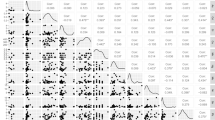Abstract
The selenium content of commercial infant formulae, processed milk and beikost was measured by hydride generation atomic absorption spectrometry after previous wet acid digestion. The median daily intake by infants (1–6 months) fed milk, soya or cereal-based infant formulae was 3.0–7.8 μg/day; lower than the mean daily intake by Belgian breast-fed infants (6.1–8.6 μg/day) and cow's milk bottle-fed infants (7.6–10.8 μg/day).
Similar content being viewed by others
References
Amin S, Chen SY, Collipp PJ, Castro-Magana M, Maddaiah VT, Klein SW (1980) Selenium in premature infants. Nutr Metab 24: 331–340
Cross JD, Raie RM, Smith H, Smith LB (1978) Dietary selenium in the Glasgow area. Radiochem Radioanal Letters 35:281–290
Farré R, Gonzalez M, Marsa M, Morros R (1981) Selenium content in commercial baby milk powders and paps. Rev Agroquim Technol Aliment 21:554–560
Fell GS, Shenkin A, Main A, Russell R, Brown A, Ottoway JM (1980) Human selenium deficiency. Proc Nutr Soc 39:A36
Flohe L, Günzler WA, Schock HH (1973) Glutathione peroxidase: a selenoenzyme. FEBS Letters 32:132–134
Food and Nutrition Board, National Research Council (1980) Recommended dietary allowances. Nutr Rev 38:290–294
Higashi A, Tamari H, Kuroki Y, Matsuda I (1983) Longitudinal changes in selenium content of breast milk. Acta Paediatr Scand 72:433–436
Levander OA (1982) Clinical consequences of low selenium intake and its relationship to vitamin E. Ann NY Acad Sci 393: 70–82
Lombeck I, Bremer HJ (1977) Primary and secondary disturbances in trace element metabolism connected with genetic disorders. Nutr Metab 21:49–64
Lombeck I, Kasperek K, Harbisch HD, Feinendegen LE, Bremer HJ (1977) The selenium state of healthy children. I. Serum selenium concentration at different ages; selenium content of food of infants. Eur J Pediatr 125:81–88
Lombeck I, Kasperek K, Bonnerman B, Feinendegen LE, Bremer HJ (1978) Selenium content of human milk, cow's milk and cow's milk infant formula. Eur J Pediatr 129:139–145
Lombeck I, Kasperek K, Harbisch HD, Becker K, Schumann E, Schröter W, Feinendegen LE, Bremer HJ (1978) The selenium state of children. II. Serum selenium content of serum, whole blood, hair and the activity of erythrocyte glutathione-peroxidase in dietetically treated patients with phenylketonuria and maplesyrup-urine disease. Eur J Pediatr 128:213–223
Lombeck I, Kasperek K, Bremer HJ (1980) Selenium requirements in children. Pediatr Res 14:1420
Millar KR, Sheppard AD (1972) α-Tocopherol and selenium levels in human and cow's milk. N Zealand Sci 15:3–15
Robberecht HJ, Van Grieken RE, Van den Bosch PA, Deelstra HA, Vanden Berghe DA (1982) Losses of metabolically incorporated selenium in common digestion procedures for biological material. Talanta 29:1025–1028
Robberecht H, Roekens E, Van Caillie-Bertrand M, Deelstra H, Clara R (1984) Longitudinal study of the selenium content in human breast milk in Belgium. Acta Paediatr Scand (in press)
Roelandts D (1982) Formulaire Thérapeutique, 9th edn. Therapeutics, Brussels, pp 465–475
Rotruck JT, Pope AL, Ganther HE, Swanson AB, Hafeman DG, Hoekstra WG (1973) Selenium: biochemical role as a component of glutathione peroxidase. Science 179:588–590
Smith AM, Picciano MF, Milner JA (1982) Selenium intakes and status of human milk and formula fed infants. Am J Clin Nutr 35:521–526
Van Caillie-Bertrand M, Degenhart HJ, Fernandes J (1984) Influence of age on the selenium status in Belgium and the Netherlands. Pediatr Res (in press)
Verlinden M, Baart J, Deelstra H (1980) Opitimization of the determination of selenium by atomic absorption spectrometry: comparison of two hydride generation systems. Talanta 27:633–639
Whitehead RG, Paul AA, Cole TJ (1982) How much breast milk do babies need? Acta Paediatr Scand [Suppl] 299:43–50
Ziegler EE, Fomon SJ (1982) Methods in infant nutrition research: balance and growth studies. Acta Paediatr Scand [Suppl] 299:90–96
Author information
Authors and Affiliations
Rights and permissions
About this article
Cite this article
Roekens, E., Robberecht, H., Van Caillie-Bertrand, M. et al. Daily intake of selenium by bottle-fed infants in Belgium. Eur J Pediatr 144, 45–48 (1985). https://doi.org/10.1007/BF00491924
Received:
Accepted:
Issue Date:
DOI: https://doi.org/10.1007/BF00491924



